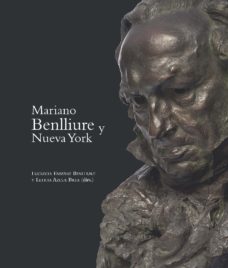Author
Lucrecia Enseñat Benlliure, Leticia Azcue Brea (eds.)
Characteristics
440 pages; 311 color illustrations; hardcover with chrome; 24,5 x 29,5 cm
Publication
Spanish; published by the CEEH, Hispanic Society of America and CSA; 2020
ISBN
978-84-15245-91-9
Price
€52,88
Buy on our site and save 5% on this book until April 30
(coupon code: DÍA DEL LIBRO)
This book is devoted to the work of the sculptor Mariano Benlliure (Valencia, 1862−Madrid, 1947) in the United States, which is mostly held in the collection of the Hispanic Society of America in New York.
Benlliure’s first New York clients were the magnate, collector and patron Henry G. Marquand, the second president of the Metropolitan Museum, who commissioned his first piece from Benlliure in 1883, and Samuel Ward, another distinguished art lover and influential member of American society who asked him for a sculpted portrait bust around the same time. His principal benefactor during the first third of the 1900s was, however, Archer M. Huntington, the founder of the Hispanic Society of America, who entrusted him with an important series of portraits of the leading figures on the Spanish cultural scene of the day, as well as purchasing other works for the institution. Nevertheless, Benlliure’s most ambitious sculpture would be the monument to congressman William A. Jones for the city of Warsaw in Virginia.
In the first part of the book renowned specialists discuss the subject from different angles: the role of the Hispanic Society on the New York culture scene during those years; figurative sculpture in Spain, including the presence of the most prominent Spanish sculptors in Latin America; the medal exhibition in New York in 1910 that marked the start of the relationship between the sculptor and the Hispanist, whose links with sculpture are analysed through his second wife the sculptor Anna Hyatt, who encouraged his contact with Benlliure; the strong ties between Benlliure and Sorolla, two of the artists who are best represented in the Hispanic Society’s collection; and the critical fortunes of the Valencian sculptor in the United States.
Each of the works Benlliure produced for the United States is thoroughly studied and contextualised in the second part of the book through documents, letters, photographs and news reports published in the press.
Lucrecia Enseñat Benlliure, great-granddaughter of Mariano Benlliure, is an architect and independent researcher. She has been studying, documenting, cataloguing and disseminating the work of the sculptor since 1997 and is currently working on his catalogue raisonné. She has lectured and delivered papers on the artist at national and international symposia as well as curating many exhibitions on his work, including Mariano Benlliure. El dominio de la materia (2013) with Leticia Azcue Brea. She was responsible for the layout and design of the Museo Municipal Mariano Benlliure in Crevillente (Alicante). In 2010 she promoted the establishment of the Fundación Mariano Benlliure, which she has directed since then as vice-president.
Leticia Azcue Brea earned her PhD from the Universidad Complutense in Madrid with a thesis on La escultura en la Real Academia de Bellas Artes de San Fernando. Catálogo y estudio, which was published in 1994. She is a member of the Cuerpo Facultativo de Conservadores de Museos and has been chief curator of Sculpture and Decorative Arts at the Museo Nacional del Prado since 2004 and a member of the board of trustees of the Museo Nacional de Escultura in Valladolid since 2007. She conducts research and publishes studies on Spanish sculpture of the eighteenth to the twentieth centuries. She has curated Solidez y belleza. El escultor Miguel Blay en el Museo del Prado (2016), among other exhibitions. She is currently writing the catalogue raisonné of the Museo del Prado’s collection of nineteenth-century sculpture.

